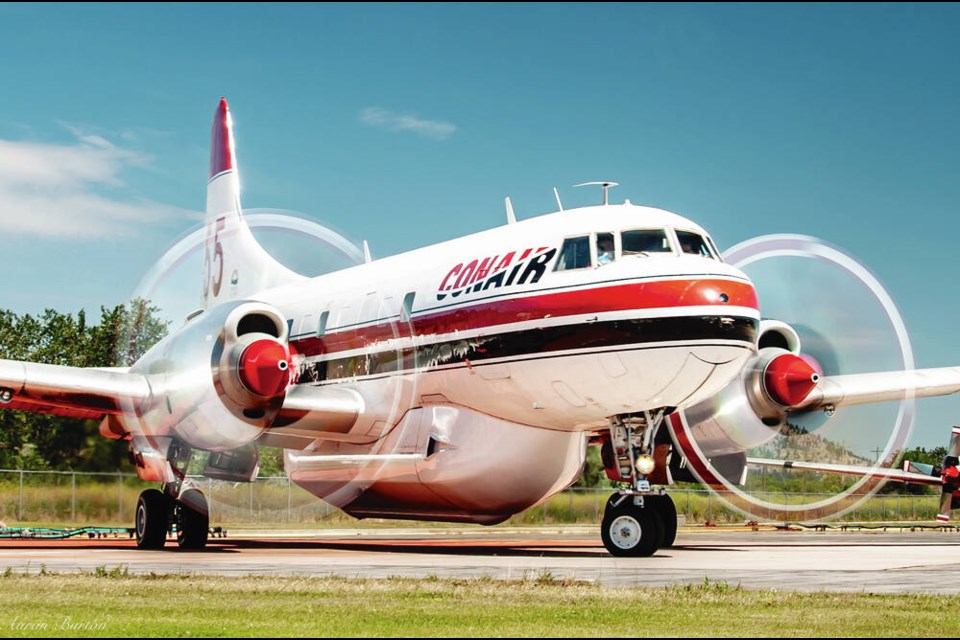The Convair 580 touched down gracefully on the tarmac at Victoria International Airport on Friday and taxied through a cascading welcome spray from two airport fire trucks.
The twin-engine turbo prop plane — a pioneer in early air-passenger travel and for the past two decades a workhorse water tanker fighting forest fires — arrived on time for retirement to the B.C. Aviation Museum.
The plane’s long-time pilot, Grahame Wilson, who flew the CV580 over his near half-century career, is doing the same.
Doug Rollins, the museum’s librarian and historian, called the noon arrival a “unique first” as the B.C. Aviation Museum lands a valuable aircraft for public viewing and an experienced pilot to volunteer as a tour guide.
Wilson, who was greeted on the tarmac by about 100 people, including his mother, who is in her 90s, called it a “special day.”
“I’ve been flying for Convair for years, so I’m looking forward to the next chapter in my book,” he said after landing.
Wilson considers the time he flew and trained others on the classic Convair 580 as the most enjoyable and fulfilling of his career. As for retirement, he looks forward to continuing his 48-year association with aviation though the museum.
The 82-foot-long Convair 580, with a wingspan of 105 feet, will be the second-largest aircraft in the museum’s collection, and will join the Convair A26 Invader, a smaller Second World War-era plane that was also converted to fight forest fires.
The museum’s largest airplane on display is a 1957 VickLoners Viscount, one of the world’s first large air passenger planes — though the museum is in the process of restoring a Lancaster bomber, one of only 17 left in the world, said Rollins.
Rollins said the latest addition will help tell B.C.’s aviation story and how it shaped the province by fighting forest fires over the past 20 years.
The aircraft was built in 1956 as a Convair 440 Metropolitan, a twin-piston-engine, all-metal airliner that seated 34 passengers in a pressurized cabin. It entered service with Sabena Air of Belgium, where it operated for 12 years before being sold in 1968 to Frontier Airlines of Denver, where it was modernized to a turboprop airliner designated the Convair 580.
Frontier operated the airliner for 17 years before selling it to Sierra Pacific Airlines of Tucson, Arizona, with whom it remained for a further 15 years.
Exported to Canada in 2000, it was converted to an air tanker and entered operations with Conair of Abbotsford, where it fought fires for 22 years in B.C. and Alberta.
Known for being agile despite its size, the CV580 was coveted for manoeuvrability with steep descents and performance in mountainous terrain and in hot and high conditions. It’s powered by two Allison engines, each with 3,750 horsepower, and could carry nearly 8,000 litres of water to fight fires.
“It’s rugged and powerful,” said Wilson, adding the plane has no computers and can be exhausting with manual controls but is very reliable.
The museum is now home to 36 historic aircraft in three large hangars that showcase 150 years of military, commercial and private aviation history in the province.
It’s the fourth-largest of its kind in Canada, and includes some unique aircraft, including the only remaining 1929 Eastman Sea Rover — the first bush plane — and replicas of the 1917 Hoffar float plane and 1910 Gibson Twin.
The museum’s library contains 7,728 books, 667 videos and 30,000 digitized and catalogued photos.
It’s located at 1910 Norseman Rd.
Visit bcam.net.
>>> To comment on this article, write a letter to the editor: [email protected]



